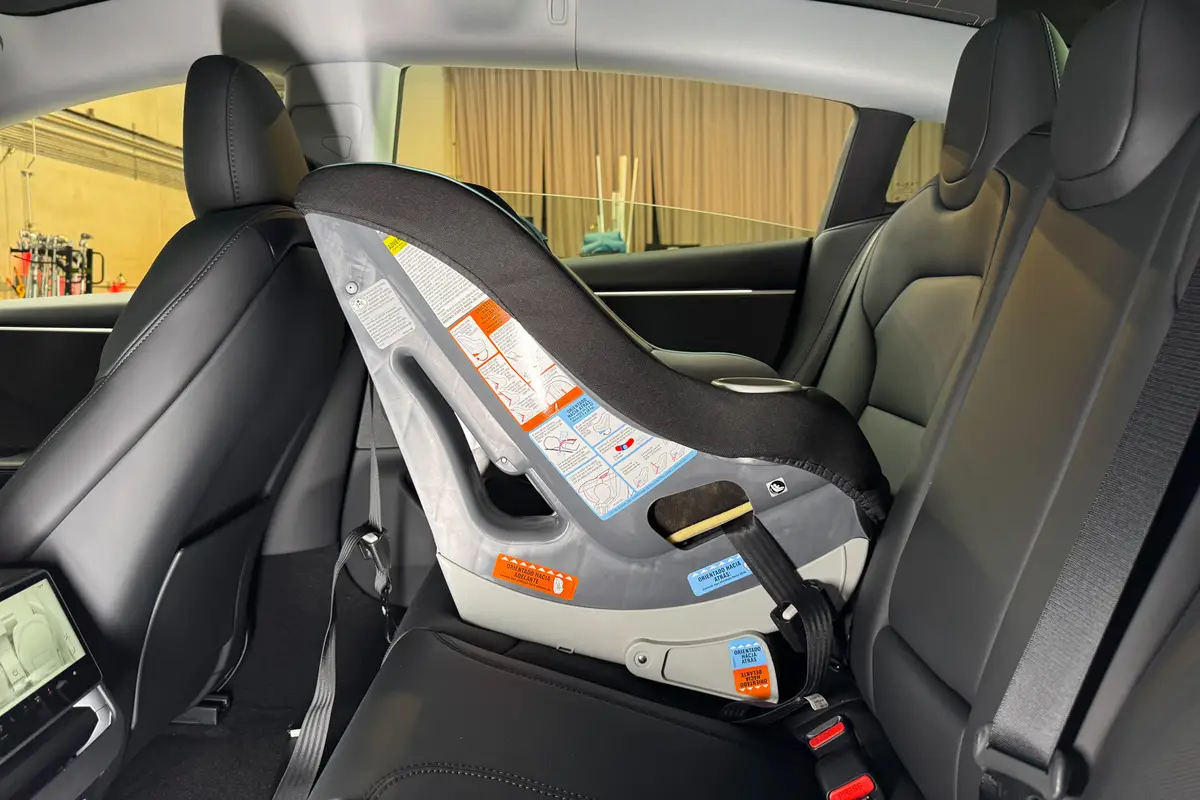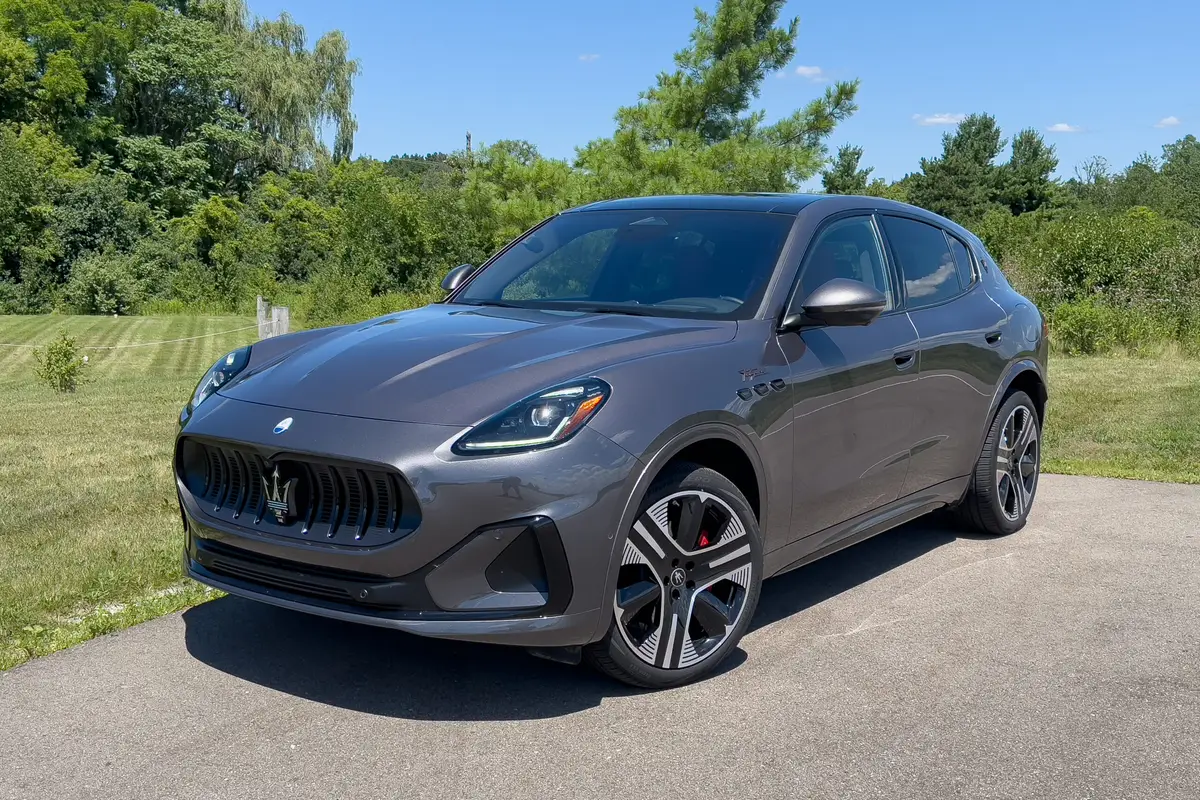Our view: 2006 Infiniti M45

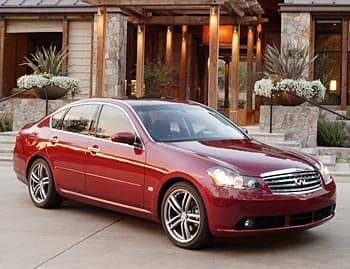
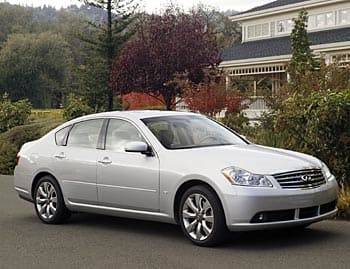
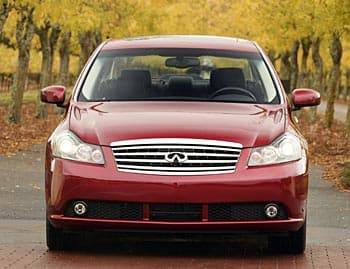


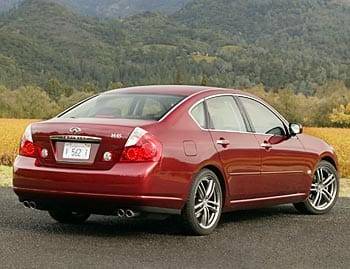
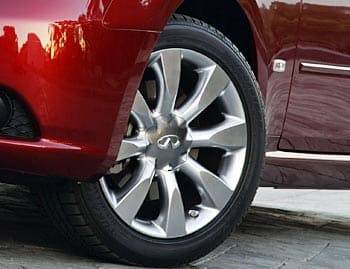
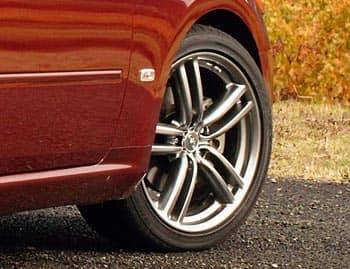
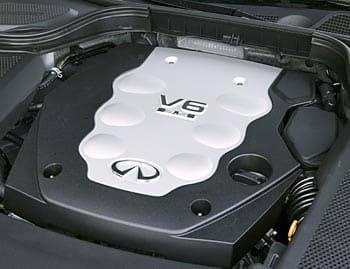
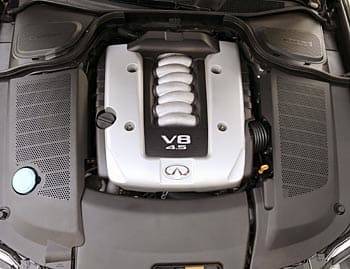
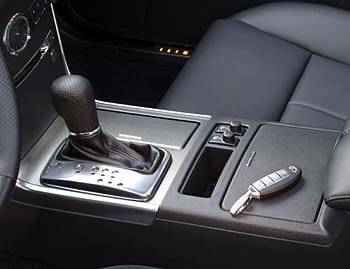
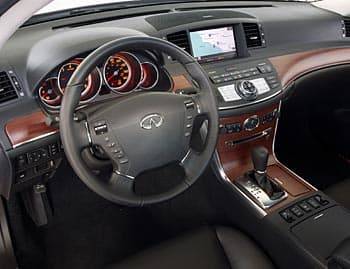
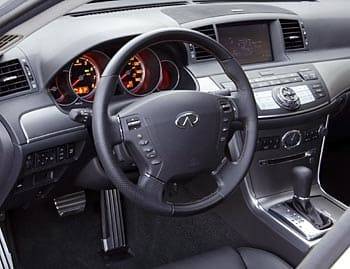
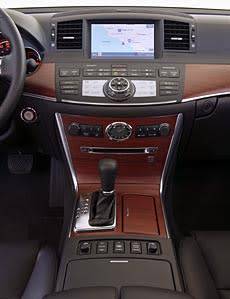
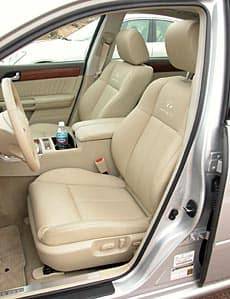
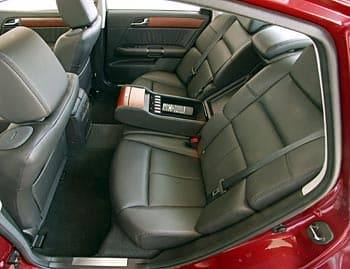
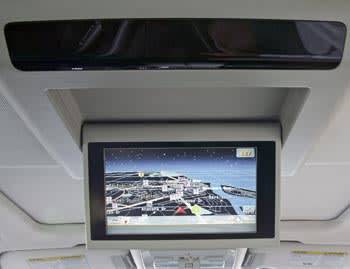
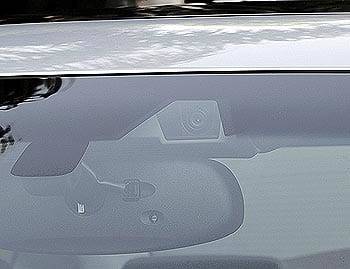
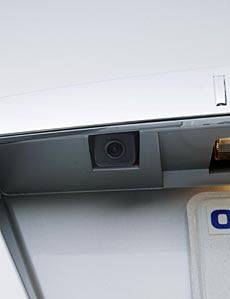
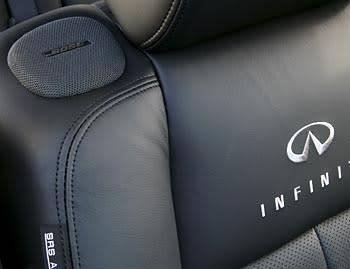




















The class of midsize luxury sedans is among the most competitive in the market. So much so that an automaker would have to be masochistic to add a new car to the fray — or have a really, really good one. At first blush, it looks like Infiniti’s 2006 M35 and M45 are really, really good cars, packed with more truly usable technology than any one car in recent memory.
Technically, Infiniti first started selling an M45 sedan in the 2003 model year, but it was a stopgap measure to fill a hole between its wildly successful G35 compact sedan and its less successful Q45 full-size sedan. This M was based on a car sold in Japan called the Cedric/Gloria. (Maybe alphanumeric model names aren’t so bad after all.) Aside from the fact that it was quick — a relatively light car powered by the larger Q45’s V-8 engine — Cedric turned out to be not very entertaining.
For 2006, Infiniti started from scratch and based its new model on the platform and philosophy that have made the G35 perhaps the most successful BMW fighter of all time. A derivation of a model sold since October 2004, in Japan called the Fuga, the 2006 M sedan should be hitting dealerships by the time you read this. (Yeah, alphanumeric model names are just fine.) This time around the car also comes as an M35 powered by the ubiquitous Nissan/Infiniti 3.5-liter V-6 engine.
Both the M35 and M45 are available in base (Luxury) and Sport trim levels. Both are rear-wheel drive. All-wheel drive (AWD), currently offered only with the V-6 Luxury, is badged M35x.
Exterior & Styling
The M has the G35 sedan’s fast profile and similar but more refined styling. Even with its 2005 sheet-metal upgrade, the G35 sedan’s rear end doesn’t have quite the appeal of the coupe’s. The M is more cohesive all around.
Like some other recently introduced cars, the M’s headlights seem to borrow from BMW’s new styling direction. Fortunately — like the other cars — Infiniti has executed the headlamps better than BMW did in the first place. The grille and raised front fenders distinguish the M unmistakably as an Infiniti.
Aside from the badging, there are no exterior differences between the M35 and M45. Variation comes with the Sport package, optional on either trim level, which replaces the 18-inch aluminum wheels with 19-inch versions. Chromed 18-inch alloy wheels also are optional.
Ride & Handling
It was only when manufacturers like Cadillac and Infiniti returned to rear-wheel drive and started to take handling and acceleration seriously that they attracted BMW buyers. The G35 has proven a formidable competitor in this regard. Infiniti gave the M sedan the same treatment, with an emphasis on handling prowess yet comfortable ride quality. Engineers started with a much more rigid foundation than in the previous M45. This is the second-generation FM (front midship) platform, which is upgraded a reported 60 percent. The front suspension uses double wishbones and the rear employs a multilink design. That’s academic; the proof is in the performance.
The M sedan exhibits all the handling chops of the G35, if not more. Between the quiet cabin and the effortless roadholding, I had to keep an eye on the speedometer to have any sense of my speed. The power steering boost errs a bit on the side of luxury rather than sport, but the ratio is quick, the wheel is responsive and steering feedback is above average, especially with the Sport trim level’s low-series tires.
The M strays a bit from Infiniti’s stated optimal front/rear weight distribution of 52/48. Both the M35 and M45 versions are 54/46 (55/45 for the M35x). Still, the rear-wheel drive allows you to balance the weight and minimize the understeer when going into and out of a turn, thanks in part to a very responsive throttle. Another feature included in the Sport trim that affects the car’s dynamics is Rear Active Steer. It uses an electronically controlled actuator in the rear suspension that pulls or pushes each side’s lower link, changing the toe angle — in effect steering the rear wheels.
We’ve seen similar capabilities most recently in Chevrolet and GMC’s full-size pickup trucks and sport utility vehicles: Recently discontinued, Quadrasteer helped the large vehicles maneuver by steering the rear wheels as much as 12 degrees, mostly at low speeds. Meant for medium to high speeds, Infiniti’s RAS steers a maximum of 1 degree, which is significant at these higher speeds. By turning the rear wheels in the opposite direction of the front pair when leading into a turn, RAS gives the feeling of sharper turn-in and makes the car feel more balanced overall. It’s almost like built-in, controlled oversteer.
At high speeds, the rear wheels turn in the same direction as the fronts, which makes for more stable lane changes and evasive maneuvers. If all this sounds complicated and gimmicky, know that it’s transparent to the driver. All I felt was that this car handled very well. Vehicle Dynamic Control, Infiniti’s electronic stability system, is standard on all M sedans. I had to turn it off to get a true feel for the car’s dynamics, after which the rear end gladly stepped out when powering through a turn. In the M35x, the AWD reacted quickly enough, transferring torque between the front and rear axles, that there was little slippage and practically no difference whether the VDC was on or off.
The Luxury trim level’s 18-inch tires are the all-season variety, rated P245/45R18 (see tire codes). Run-flat versions are available, though all M sedans include direct tire-pressure monitoring. The Sport trim level’s tires are Bridgestone Potenza RE050A summer performance tires rated P245/40R19. These make for better grip in warm weather, but they are not to be used in winter. Bear in mind what this means if you buy the Sport trim and live in a wintry climate: According to TireRack.com, all-season and winter tires are available in this size, but prices for these and replacement summer tires all range from above $200 to around $300 apiece. To save money and protect the expensive rims, you’d be better off with a separate set of higher-series all-season or winter tires on smaller, cheaper wheels.
Going & Stopping
It’s no mistake that eight of Nissan’s 11 models and four of Infiniti’s six use the VQ-series V-6 engine. It’s simply a terrific power plant. The M35 uses the more common 3.5-liter version. The M45 uses a newly updated version of the Q45 sedan’s 4.5-liter V-8. As reflected below, both are potent.
| Engines | ||||||||||||||
|---|---|---|---|---|---|---|---|---|---|---|---|---|---|---|
| Model | M35 | M45 | ||||||||||||
| Engine Type | 3.5-liter V-6 | 4.5-liter V-8 | ||||||||||||
| Horsepower | 280 @ 6,200 rpm | 335 @ 6,400 rpm | ||||||||||||
| Torque (lbs.-ft.) | 270 @ 4,800 rpm | 340 @ 4,000 rpm | ||||||||||||
| Redline | 6,600 rpm | 6,600 rpm | ||||||||||||
| Required Gasoline | premium unleaded (91 octane) |
premium unleaded (91 octane) |
||||||||||||
| Manufacturer data | ||||||||||||||
Both engines mate to a five-speed-automatic transmission that includes clutchless-manual operation. (There’s no word of a manual gearbox in the M’s future.) Considering that there’s no stick shift, this automatic should keep most drivers happy. It responds quickly and kicks down appropriately, with little of the lag that plagues too many high-gear-count automatics these days.
The manual mode also impresses, executing a two-gear downshift quickly. It also employs rev matching, whereby the engine rpm automatically jumps upon a downshift to match the transmission speed. This makes the transition smooth and saves wear. The gear selector is a nice, short lever of the sort you see occasionally with a manual but almost never with an automatic. Pressing it forward upshifts; rearward downshifts — the more intuitive but by no means universal arrangement. There are no paddle shifters on the steering wheel, which is OK by me.
The only thing missing from this transmission is a sport mode. Yes, the normal auto mode adjusts to one’s driving style, but it’s still nice to be able to slide the lever over and know that the drivetrain will rev higher before shifting and stay in a low gear longer to provide more engine braking. This is what BMW automatics do when the lever is moved to the sequential-shifting gate (before the driver shifts manually). In the M sedan, engaging the manual mode automatically downshifts from 5th to 4th, Infiniti says, because this is the most common next step.
For most drivers, the M35’s V-6 will provide more than enough power, sprinting from zero to 60 mph in less than 7 seconds. For roughly $7,000 you can step up to an M45, whose V-8 shaves another second off the 0-to-60-mph time.
The four-wheel disc brakes have ABS, electronic brake-force distribution and brake assist. They perform very well, offering fine control and plenty of stopping power. This is where one begins to appreciate what separates the exceptional cars from the good ones. When the steering, handling, acceleration and braking are all brilliant, they inspire in the driver an even level of confidence. The complete car hides no ugly surprises.
The Inside
The main complaint upon the G35’s debut was its interior design and quality. Infiniti was listening. The M sedan offers classy environs, rich with low-gloss materials, genuine rosewood and, in the Sport trim level, real aluminum trim pieces. I’m not a fan of brown on black, but the wood’s matte finish is a nice change.
The power leather front seats are comfortable and supportive. The Sport trim level’s have more prominent side bolsters and gray seam piping. Heated/cooled front seats are standard in the Sport trim level and otherwise available in option packages. Infiniti again heard the complaints about the G35’s power seat controls, which faced upward alongside the cushions where they efficiently collected dust and crumbs. The M’s are back in the conventional place.
Otherwise ergonomics are pretty good. A 7-inch LCD readout mid-dashboard is standard equipment; an optional GPS-based navigation system replaces it with an 8-inch screen. The good news is that Infiniti no longer combines a joystick menu control with an enter button (which never seems to do what you’re trying to do), and the bad news is that they haven’t gone to a touchscreen. The control is a rotary knob with push-buttons on and around it. There are also controls on the steering wheel, including one that activates a voice-recognition feature for spoken commands. The idea, Infiniti says, is to give you four different ways of controlling the stereo; you pick the one you like. Swell, but when it comes to navigation, I’ll trade all four for one choice: a touchscreen. A knob is just not the way to select letters from the alphabet.
Also standard are keyless access and ignition. The dashboard’s engine start/stop push-button, again, might seem gimmicky, but the benefit is that you never have to remove the remote transmitter from your pocket or purse to unlock the car or to start the engine. It also prevents you from locking the keys in the cabin or trunk. Once you have this feature, you won’t want to go back.
The backseat is reasonably roomy and comfortable. By the numbers, the M sedan’s backseat dimensions are mostly greater than those of the Acura RL and BMW 5 Series. However, the center floor hump is no smaller than the other cars’, so the center seat is only so comfortable. Heated seats with power-reclining backrests come in the optional Premium Package, but only in the M35.
There are many more features that I address in the Features section below.
Safety
As of this writing, the M sedan has not been crash tested. That leaves us with an audit of the safety features, of which there are many.
The M sedan is the first car and second model on the market (following Infiniti’s FX SUV) to offer lane-departure warning: A camera in front of the rearview mirror watches the lane markings ahead. If the car begins to wander out of its lane or off the side of the road, LDW beeps a warning. (Infiniti says this type of inadvertent lane change is responsible for 55 percent of fatal motor vehicle wrecks.) Using the turn signal defeats the system, so LDW actually encourages signal use as well. One can turn the system off too. It comes in the optional Technology Package.
The optional Journey and Premium packages include Pre-Crash seat belts for the front seats. Where many cars offer pretensioners that fire after impact, this feature snugs up the seat belts when the car’s under panic braking, for better restraint if a collision follows. If the crash is averted, the tensioners release again. The frontal airbags feature dual-stage deployment; the passenger’s is connected to the Occupant Classification System, which determines the passenger’s weight and triggers the airbag accordingly, if at all. Side-impact airbags are installed in the front seat backrests, and side curtain-type airbags protect front and backseat occupants in a side impact. A power tilt/telescoping steering wheel helps drivers distance themselves properly from the airbag.
The front seats have active head restraints for added protection in a rear-end collision.
Included with the optional adaptive cruise control — which uses a laser in the front bumper to judge distance and keep constant the car’s following distance — is a Preview Braking feature. If the laser determines that the car is closing too fast on an object, it pre-pressurizes the brake assist so full braking is activated when the driver steps on the brake pedal. The system won’t brake the car by itself, but it can shorten the stopping distance, which might be the difference between collision and aversion.
More arguable safety features are mentioned below.
Features
The high tech doesn’t end with the safety and other features mentioned above. Unless otherwise mentioned, all the following features are optional and mostly included in packages. (For all the details and pricing, click on the Optional Equipment button above and to the left.)
The M’s xenon high-intensity-discharge headlights, standard on the Sport trim level and optional on the Luxury, are adaptive, which means they sweep up to 20 degrees in the direction of a turn. This keeps the light on the road ahead rather than off the opposite side of the road.
The Journey and Premium packages come with a rearview camera that presents on the dashboard LCD a wide-angle video image of the view behind the car, activated when the transmission is in Reverse. An overlay of two lines shows roughly where the car’s fenders are — a huge improvement over systems that leave this determination to guesswork.
The Journey Package includes a Bose premium stereo. The Technology package ups the ante to a Bose system with 5.1-channel DVD surround sound and Personal Surround speakers. The DVD Audio and 5.1-channel digital surround are not new in the market, but the Personal Surround speakers — one mounted behind each shoulder in the front seat backrests — make far better use of the format than any car I’ve driven. These localized speakers and their adjustable level produce a convincing surround field without turning the whole cabin into an echo chamber. They even create respectable ambience content from stereo CDs. Very cool.
No longer limited to minivans and SUVs, an optional DVD video system includes a power-retracting 8-inch screen in the ceiling and wireless headphones.
Standard features also include the Bluetooth wireless connection standard for cellular phone integration, and electrochromatic interior and — more important — exterior mirrors, the latter also heated and with integrated turn signals.
Cargo & Towing
The M sedan has a trunk capacity of 14.9 cubic feet, though the optional full-size spare tire knocks it down to 11.4 cubic feet. While 14.9 cubic feet is respectable for this class, note that the backseat doesn’t fold down, as some competitors’ do. The M has only a ski pass-thru.
The M sedan is not rated for towing.
M Sedan in the Market
Based on all the things I hold dear, the Infiniti M sedan is a winner. I suspect it will be a hit on the sales floor, but that depends on a few things, not the least of which is the fact that it’s effectively a new entry in a class that already has many choices. Price is another factor. While the M’s standard equipment list is by no means spare, many of the options are tied up in packages, the most expensive of which lists for more than $10,000. If you want some of the items in it but not the others, you’ll have to cough up the dough or do without.
As you can imagine, it’s easy to shoot past the competitive sticker price. A loaded M35 hits $51,000 to $52,000, depending on the trim level and including the destination charge. It’s roughly $54,500 for a loaded M35x. Start with an M45 and you can get close to $59,000 loaded with options.
| Send Joe an email |

Former Executive Editor Joe Wiesenfelder, a Cars.com launch veteran, led the car evaluation effort. He owns a 1984 Mercedes 300D and a 2002 Mazda Miata SE.
Latest news

10 Biggest News Stories of the Week: Hyundai Palisade Accelerates to the Top, Genesis G80 Jumps Up
